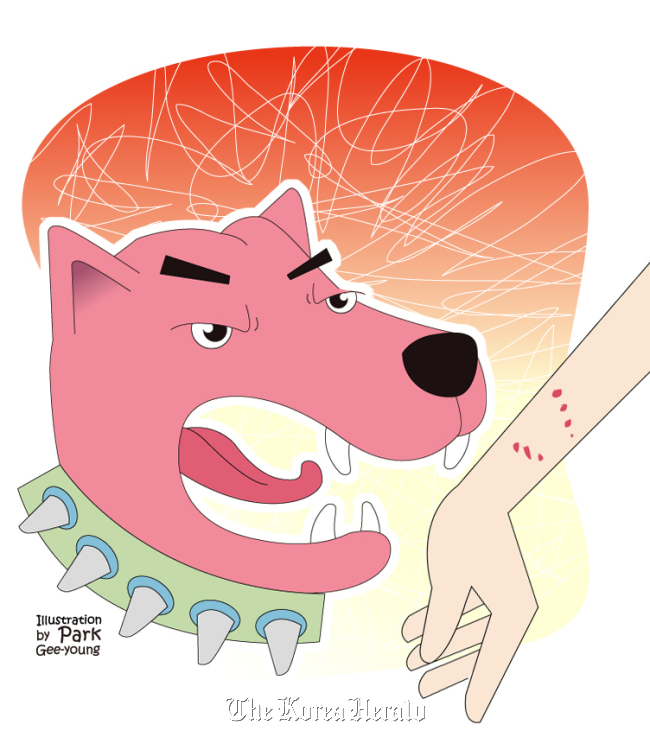
Rabies, also known as hydrophobia or mad dog disease, occurs when the nervous system becomes infected with the rabies virus. It is a communicable disease between men and warm-blooded animals.
Rabies is a contagious disease, fitting into the third prevention category of the officially designated communicable diseases and the first Domestic Animal Infectious Disease Control Law.
When animals are infected with this disease, it is called rabies, and when people are infected, it is called hydrophobia, since people will show symptoms of fearing water. People can get infected through bites of dogs and other mammals with rabies through the animal’s saliva. The virus then moves to the central nervous system and multiplies to induce symptoms.
Animals that are vulnerable to rabies include dogs and other wild animals such as raccoons, badgers, foxes, skunks and bats.
After rabies was first found in Korea in 1906, there were continuous reports of outbreaks; but after the introduction of a vaccine around the 1950s, the rates gradually declined. More recently, dozens of rabies cases are reported around north Gyeonggi Province and regions of Gangwon each year, mainly because of infected dogs, cows and raccoons.
2. Symptoms of rabies (hydrophobia)
Animals with rabies usually discharge the virus through saliva three days before the rabies symptoms are shown and eventually die within seven days. Animals will try to hide in dark places and will easily get upset and become aggressive upon even mild stimulation.
They will have a decreased appetite and large amounts of saliva production. Animals with rabies let out a horrible shriek, the contraction of face muscles makes their facial expressions turn ugly and their whole body becomes paralyzed before they die.
People with hydrophobia usually have an incubation period of around 2-8 weeks but some people may not show any signs of hydrophobia until many years after becoming infected.
Early symptoms include fever, lethargy, loss of appetite and headaches, but at this stage it is hard to suspect that these are the symptoms from hydrophobia. Later on, people with hydrophobia will become anxious, irritable and will hallucinate and have mental aberration, convulsion of muscles and high fever as well as increased tears and saliva secretion. People will feel severe pain while drinking from the unintended convulsion of muscles used while drinking and will eventually become very afraid to drink. People will show signs of nerve paralysis before entering a comatose state, resulting in death of the respiratory center and thus paralysis.
3. Treatment for rabies
Once neurologic symptoms occur, most people will die. Other than the symptomatic management, there is no cure. Hence, it is important to take preventive measures once exposed to this virus.
4. Prevention of Rabies
To eradicate rabies from wild animals, the Ministry of Agriculture and Forestry has introduced bait vaccines in areas where rabies is reported as well as in other neighboring areas. The vaccines are introduced by using bait for wild animals. Also, livestock and domestic animals must be vaccinated against rabies and must stay away from contact with wild animals and other livestock.
If bitten by an animal, the wound needs to be disinfected and action needs to be taken to prevent infection and tetanus. At the same time, a decision needs to be made on whether action will be taken to prevent rabies. To prevent rabies, a vaccine and rabies immunoglobulin will be injected but these are hard to find in typical hospitals. They must be purchased from places such as Korea’s rare medicine and medical supplies center and then administered.
First, if any animals fall under the category then they need to be examined to see if the symptoms of rabies are present. If rabies symptoms are present or if the animal has already died then prevention measures will take place and the animal’s brain cells must be examined. If the animal does not show rabies symptoms they will be kept under probation for around 10 days and if they show symptoms or die during that time they will also have the brain cells examined. In cases where the animal flees, they will still need preventive treatments.

By Chung Doo-ryeon
The author is a professor of Infectious Diseases at Sungkyunkwan University School of Medicine and doctor at Samsung Medical Center. ― Ed.
-
Articles by Korea Herald










![[Hello India] Hyundai Motor vows to boost 'clean mobility' in India](http://res.heraldm.com/phpwas/restmb_idxmake.php?idx=644&simg=/content/image/2024/04/25/20240425050672_0.jpg&u=)









